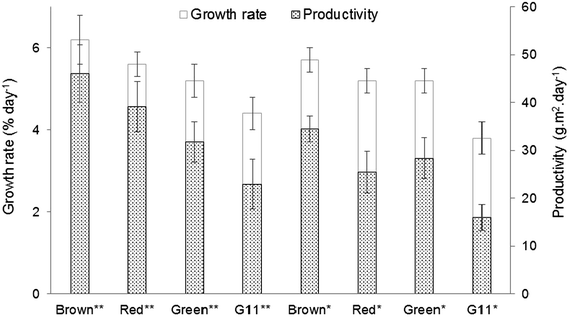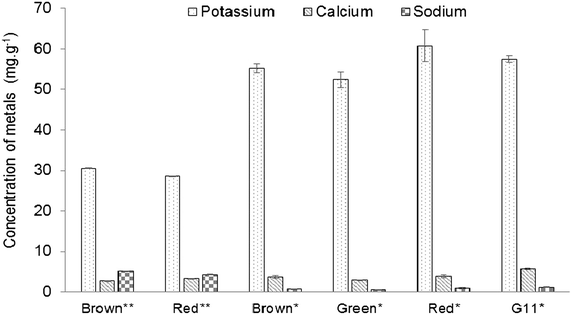Chemical analysis and biorefinery of red algae Kappaphycus alvarezii for efficient production of glucose from residue of carrageenan extraction process
- PMID: 27293482
- PMCID: PMC4902961
- DOI: 10.1186/s13068-016-0535-9
Chemical analysis and biorefinery of red algae Kappaphycus alvarezii for efficient production of glucose from residue of carrageenan extraction process
Abstract
Background: Biorefineries serve to efficiently utilize biomass and their by-products. Algal biorefineries are designed to generate bioproducts for commercial use. Due to the high carbohydrate content of algal biomass, biorefinery to generate biofuels, such as bioethanol, is of great interest. Carrageenan is a predominant polysaccharide hydrocolloid found in red macroalgae and is widely used in food, cosmetics, and pharmaceuticals. In this study, we report the biorefinery of carrageenan derived from processing of experimental strains of the red macroalgae Kappaphycus alvarezii. Specifically, the chemical composition and enzymatic hydrolysis of the residue produced from carrageenan extraction were evaluated to determine the conditions for efficient generation of carbohydrate bioproducts.
Results: The productivity and growth rates of K. alvarezii strains were assessed along with the chemical composition (total carbohydrates, ash, sulfate groups, proteins, insoluble aromatics, galacturonic acid, and lipids) of each strain. Two strains, brown and red, were selected based on their high growth rates and productivity and were treated with 6 % KOH for extraction of carrageenan. The yields of biomass from treatment with 6 % KOH solution of the brown and red strains were 89.3 and 89.5 %, respectively. The yields of carrageenan and its residue were 63.5 and 23 %, respectively, for the brown strain and 60 and 27.8 %, respectively, for the red strain. The residues from the brown and red strains were assessed to detect any potential bioproducts. The galactan, ash, protein, insoluble aromatics, and sulfate groups of the residue were reduced to comparable extents for the two strains. However, KOH treatment did not reduce the content of glucan in the residue from either strain. Glucose was produced by enzymatic hydrolysis for 72 h using both strains. The glucan conversion was 100 % for both strains, and the concentrations of glucose from the brown and red strains were 13.7 and 11.5 g L(-1), respectively. The present results highlight the efficiency of generating a key bioproduct from carrageenan residue.
Conclusions: This study demonstrates the potential for glucose production using carrageenan residue. Thus, the biorefinery of K. alvarezii can be exploited not only to produce carrageenan, but also to generate glucose for future use in biofuel production.
Keywords: Bioproducts; Carrageenan; Chemical composition; Digestibility; Glucose; Kappaphycus alvarezii; Residue.
Figures





References
-
- Mata TM, Martins AA, Caetano NS. Microalgae for biodiesel production and other applications: a review. Renew Sustain Energy Rev. 2010;14:217–232. doi: 10.1016/j.rser.2009.07.020. - DOI
-
- Hayashi L, Reis PR. Cultivation of the red algae Kappaphycus alvarezii in Brazil and its pharmacological potential. Braz J Pharmacogn. 2012;22:748. doi: 10.1590/S0102-695X2012005000055. - DOI
-
- Zodape ST, Mukherjee S, Reddy MP, Chaudhary DR. Effect of Kappaphycus alvarezii (Doty) Doty ex silva. extract on grain quality, yield and some yield components of wheat (Triticum aestivum L.) Int J Plant Prod. 2009;3(2):1735–8043.
-
- Gelli V, Barbieri E: Cultivo e aproveitamento da macroalga Kappaphycus alvarezii para pequenos maricultores. Aquicultura no Brasil: Novas Perspectivas. In: Brito PAM, Brito JRM, editors. Pedro & João; 2015. p. 641–58.
-
- Li Y, Horsman M, Wu N, Lan CQ, Dubois-Calero N. Biofuels from microalgae. Biotechnol Prog. 2008;24(4):815–820. - PubMed
LinkOut - more resources
Full Text Sources
Other Literature Sources
Research Materials
Miscellaneous

